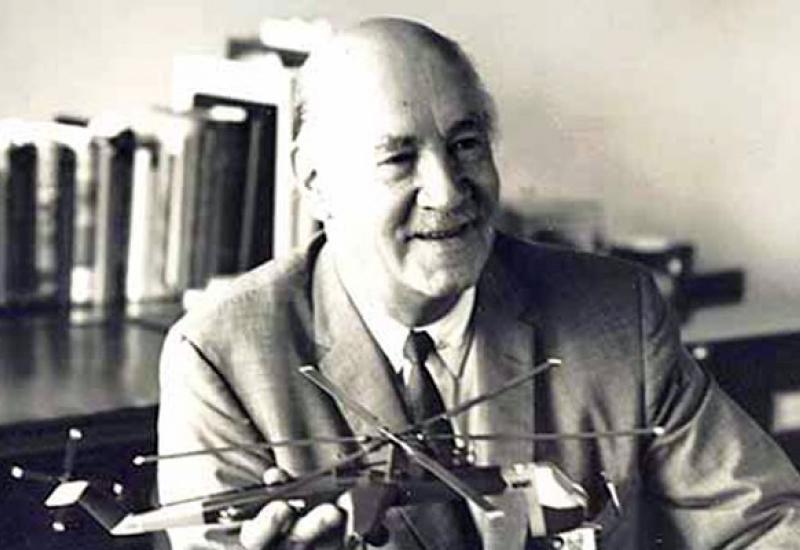The boy liked to listen to his mother’s stories about the infinite universe, mysterious stars, about the secrets of the seas and oceans, the wonderful and exciting world that stretched far beyond the walls of the Kyiv apartment. But what mostly impressed the boy’s imagination was the story about the genius of the fifteenth century, Leonardo da Vinci and his idea of an "iron bird" - a flying machine that had to take off in the air under the influence of a powerful screw without any acceleration.
One day after reading Jules Verne's novel "Robur the Conqueror" the boy had a dream as if he was on the board of a ship. He imagined that he was entering the luxurious cabin, and from the windows he could see far below the sea island with green trees. The boy did not know that his dream would come true in thirty years - that he would be on the board of amphibious aircraft designed by himself ...
The boy's name was Igor Sikorsky. He was lucky to bring to life most of his childhood dreams and to become one of the most colorful figures of the XX century - desperate pilot of the first aircraft, the creator of the "iron bird" which the previous generation could not even imagine, thinker and philosopher, a man who in a five century period made the dream of the great Leonardo da Vinci come true...
Family
Sikorsky family was well known in Kyiv . First of all, thanks to his father - Ivan, a prominent psychiatrist, whose academic work has not lost its importance till nowadays. MD, a member of several scientific societies, longterm Chairman of the University of St. Vladimir in Kyiv , founder and editor of the journal "Problems of neuro-psychic medicine and psychology," he had time and was actively engaged in social activities. He participated in the spiritual and religious life of Kyiv, as the son and grandson of Orthodox priests who finished religious school and seminary. Outstanding artist Viktor Vasnetsov immortalized figure of Ivan Sikorsky in the paintings of the cathedral, choosing him as the model for the image of St. John the Baptist.
Igor Sikorsky was born on June, 6 (May, 25) 1889. His mother, Maria Stefanovna, played an important role in his life. She was a highly educated woman, but devoted her life to the family, which consisted of five children. The Sikorsky house was filled with comfort and creative atmosphere, which was necessary for the harmonious development of outstanding individuals. The childhood of the future aircraft designer was illuminated by the light of culture, art and deep knowledge about the world that he took from his family and which determined his fate.
Years of study
In 1900, Sikorsky entered the First Kyiv Gymnasium - the oldest Kyiv school with great educational traditions. Over the years, among its graduates were prominent painter Nikolai Ge, Nikolai Zakrevskii, Kyiv researcher, writer and statesman Anatoly Lunacharsky, the scientist-economist Nikolai Bunge, writers Konstantin Paustovsky and Mikhail Bulgakov and many other prominent personalities. However, education in the classical school was purely humanitarian and a boy was interested in sciences. Elder Igor’s brother Sergei studied at the Sea Cadet Corps in St. Petersburg and talked a lot about this privileged school, which during two centuries was finished by famous naval, marine engineers and scientists whose names were inscribed in gold in the history of the Russian Empire. So his parents decided that the youngest son had to study there.
Education in the Sea Cadet Corps was successful for Igor, but he quickly realized that the military career, related to the service at sea, was not attractive to him. Meanwhile finally range of his interests was determined: he tried to keep track of all the new items that appeared in technical areas, often in their spare time he designed something in educational workshops. After the appearance of the first newspaper reports about the flying Americans - the Wright brothers - the decision was finally made: he wanted to build the airplanes and make them fly. So after graduating in 1906, he left public class building with the intent to go to school, where he could make his dreams come true. However, this had not happened in Russia. In addition, due to the revolutionary events of 1905 most of the universities in the country have been temporarily closed. The parents decided to send their son to study abroad – the Professor of the Kyiv University had such an opportunity.
Igor Sikorski departed for Paris, where he began to learn science in a technical school of Dyuvinyo. However, was not content with the level of training there and after six months he returned home, where he entered the Kyiv Polytechnic Institute of Alexander II.
KPI was founded in 1898 as the model of the Paris Ecole Politeknik, higher technical school of a new type, where students received a deep natural scientific fundamental knowledge in mathematics, physics, chemistry and other disciplines, and which had teaching general engineering courses. Training there was combined with professional and practical work in production and in the laboratory. It encouraged research and practical work of teachers and students in core academic circles. From the beginning, the Institute had four departments: mechanical, chemical, agricultural and civil engineering. But in 1899, the teachers promoted the creation of the fifth department – the Aero department.
These initiatives were headed by one of the largest aviation enthusiasts of those times in Kyiv - Professor Nikolai Artemyev, a talented student of Nikolai Zhukovsky. Opening of the department then failed, so by his initiative in 1905-1906 the mechanical department of KPI organized the aeronautical section of airplanes, helicopters, engines and Ornithopters. Workshop was actually the main R & Design aviation unit of the Russian Empire. No wonder for the period of 1909-1912 years Kyiv enthusiasts have created about 40 different types of aircraft - more than have ever been created in another center of Russian aviation - St. Petersburg. Naturally, an active member of helicopter building process was Igor Sikorsky.
The first construction
In summer of 1908 student Sikorsky began his work on the design and construction of his first helicopter. The work was done in the court of the parental estate and aviogarage of KPI. Igor badly felt lack of the required power output. In January, 1909 he went to Paris to gain the experience there and buy the engine. We must pay tribute to his father, as he realized that the youngest son’s interest was not a temporary admiration, so he not only helped him with money, but also blessed his future work. Letters of recommendation to one of the most famous aviators of the time Ferdinand Ferber were provided to him by the KPI professor, the author of the first national structures gliders Nikolay Delaunay. Personally Ferber was the first Sikorsky flight instructor and advisor in selecting appropriate materials and equipment. After three months in France, Sikorsky returned home, not only with new knowledge, and scientific literature, but most importantly - with 25-powered engine "Anzani" for his helicopter.
But unfortunately, the first helicopter could not get up into the air. However, his tests showed many features which have been taken into account in the design of devices of that kind. Taking into account the results of tests and one more visit to Paris in spring of 1910 Sikorsky created his second helicopter. However, it failed to take off. The reason was not the mistakes and errors of the developer, but the absence of the necessary weight and engine power.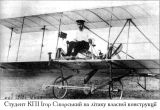 The young designer was aware of that and began to develop his first airplane. Together with his friend from the institute Theodore Bylinkin he headed the team of associates. Young enthusiasts organized special department in two specially constructed for this purpose hangars in KPI and Kurenyovka. Volunteers aircraft designers were his classmates - students. Also the workers were hired - tinsmith, carpenters and locksmiths. The result of joint work of Bylinkin, Sikorsky and another Polytechnic member - Basil Jordan, were the aircrafts BIS-1 and BIS-2. Among the products of Bylinkin and Sikorsky were snowmobile own designs inspired by 1909 Kyiv sports festival at Cave racetrack. For some time Bylinkin retired from active development activities, workshops and moved to the I.Sikorsky. That is where they built machines that could confidently fly - the C-3, C-4, C-5 and C-6 record.
The young designer was aware of that and began to develop his first airplane. Together with his friend from the institute Theodore Bylinkin he headed the team of associates. Young enthusiasts organized special department in two specially constructed for this purpose hangars in KPI and Kurenyovka. Volunteers aircraft designers were his classmates - students. Also the workers were hired - tinsmith, carpenters and locksmiths. The result of joint work of Bylinkin, Sikorsky and another Polytechnic member - Basil Jordan, were the aircrafts BIS-1 and BIS-2. Among the products of Bylinkin and Sikorsky were snowmobile own designs inspired by 1909 Kyiv sports festival at Cave racetrack. For some time Bylinkin retired from active development activities, workshops and moved to the I.Sikorsky. That is where they built machines that could confidently fly - the C-3, C-4, C-5 and C-6 record.
Construction of last was precedied by the first aerodynamic experiments which were carried out at self-organized Sikorsky plant. Their results were taken into account in the design and manufacture of nacelle for the pilot with passengers, chassis, fuel tanks and radiator, together with the use of a powerful 100-horsepower engine "Argus" on December 29, 1909 the world record for speed - 111 km / h. Sikorsky flew his own airplanes. Distinguished records and subsequent development of the young designer were introduced in C-6A. p>
Based on the fundamental underlying and deep engineering knowledge that Igor Sikorsky received in KPI he has consistently developed his own theory of the construction of aircraft. Its basis was the original method of calculation of the previous flight as future machines. This gave designer the opportunity to determine in advance the general form of all the main features and characteristics of the airplane - its horizontal and vertical velocity, time and distance run and more. Airplane, made by Sikorsky in Kyiv , in practice, confirmed the correctness of his approach, calculations and graphic constructions.
In April, 1912 C-6A was shown at a Moscow exhibition of aeronautics, where it received the Grand Gold Medal. Russian Technical Society of I.Sikorsky was awarded with the medal "For useful work in aeronautics and for independent development of the airplane systems, which gave excellent results."
Chief constructor
Right after this the KPI student Igor Sikorsky was invited to work by prominent organizer of industry of those years, chairman of the St. Petersburg company "Rus-Baltic Wagon Works" (RBVZ) Michael Shidlovskii. The young aviator became the chief designer of the air branch of the famous company.
Enterprise is associated with the highest achievements of I.Sikorsky in the aircraft industry in Russia. Here he was able to realize the desire to increase capacity and improve reliability and safety of aircraft by equipping multiple engines. In the first decades of the twentieth century, the decision was considered to be truly pioneering. In the short term there were built multi-engined airplanes "Grand" and "Ruthenian knight" that were the predecessors of the grand four-"Ilya Muromets", which was destined to become the best aircraft of the First World War. It was developed by his arms, formed a militant compound these giants - a squadron of aircraft - and organized training of their crews.
It should be noted that initially the State Duma strongly opposed the allocation of funds for the purchase of these aircrafts by military department. The reason for refusal was the widely believed opinion that such a huge machine will not go higher than 1,000 meters. In response to an invitation Sikorsky made a flight with them on board and set a new world record of height - 2000 meters! But the biggest pessimists were convinced by ultra-long flight, made personally by Sikorsky, along with three crew members in June, 1914 at the route Kyiv- St.Petersburg.
The morning of June 17, 1914 (under Art. Cent.) turned out to be grim in Kyiv . Heavy clouds almost clung to the old bell tower, and it seemed to pour on the ground with strong rain. However, the bad weather did not stop several dozen members of Kyiv Ballooning Society, KPI students and teachers and journalists to gather at Kurenisvkyi airport. All stared at low sky. Finally everybody heard singing of engines - and suddenly the clouds of gray jelly were popped by airplane unseen before construction. It quickly increased in size so that it was so clear that you could distinguish its all four motors and appreciate the strength and power of that vast man-made bird. Airplane on the airfield made a large circle and gently landed. The first stage of flight "St.Petersburg-Kyiv".
Its second phase - the flight from Kyiv to St. Petersburg – on June, 29 began with one stopover for refueling and lasted just over fourteen hours. At the airfield in St. Petersburg brave pilots personally greeted and congratulated the Emperor of Russia - Tsar Nikolay II. The public and the press hailed the developer of "Ilya Muromets" and members of the flight, because the world was proven by the benefits of multi-engined cars and that they determined the future of aviation. The first experience was also gained by flying in bad weather conditions. However, the real importance of the event was clouded by depressing feeling of WWI ...
The First World War
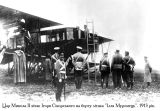 During the First World War the Russian Army was not only using the multi-engined "Murom", but also other airplanes of Sikorsky: light fighter aircraft, maritime reconnaissance, light reconnaissance fighter, twin-engine fighter-bomber and attack aircraft - almost a full fleet of all types of military aircraft. This work was to improve the "Murom" . Adjustments to the design were made as a result of combat use of airplanes and the wishes of the crew. That's why much of their time was spent not on the Sikorsky plant, but directly in the areas of operations. It is known that the C-22 (the official name of "Ilya Muromets") had more than two dozen versions. Their characteristics impressed contemporaries: the scope of the upper wing ("Ilya Muromets" was a biplane) reached 32 meters, the length of the fuselage at different modifications ranged from 17.1 to 23.5 meters, takeoff weight - more than 5 tons of speed in level flight - 140 km / h, altitude - 4 thousand meters. "Murom" had a specially designed hangers for bombs obladnuvalysya first mechanical and then electrical and optical sight bomboskydachem. According to archive data, in general the military establishment ordered 85 machines of that kind.
During the First World War the Russian Army was not only using the multi-engined "Murom", but also other airplanes of Sikorsky: light fighter aircraft, maritime reconnaissance, light reconnaissance fighter, twin-engine fighter-bomber and attack aircraft - almost a full fleet of all types of military aircraft. This work was to improve the "Murom" . Adjustments to the design were made as a result of combat use of airplanes and the wishes of the crew. That's why much of their time was spent not on the Sikorsky plant, but directly in the areas of operations. It is known that the C-22 (the official name of "Ilya Muromets") had more than two dozen versions. Their characteristics impressed contemporaries: the scope of the upper wing ("Ilya Muromets" was a biplane) reached 32 meters, the length of the fuselage at different modifications ranged from 17.1 to 23.5 meters, takeoff weight - more than 5 tons of speed in level flight - 140 km / h, altitude - 4 thousand meters. "Murom" had a specially designed hangers for bombs obladnuvalysya first mechanical and then electrical and optical sight bomboskydachem. According to archive data, in general the military establishment ordered 85 machines of that kind.
Emigration
Suddenly everything was destroyed. After the events of February 1917 work of RBVZ slowed down and almost stopped for a while. Subsequently Bolshevik power decided to roll aviation industry in the country. Soon this attitude of the part of government towards development of its own aviation industry has undergone significant change, but the time and, more importantly, a lot of skilled workers were partially lost: someone had just left the aircraft and survived, someone was repressed, someone went abroad. Among the latter was Sikorsky.
Among the reasons that forced him to leave the homeland, there was a real threat of arrest and repression. Igor Ivanovich was secretly warned about it because his father was consistent monarchist, and after the famous Bayliss case where an expert supported the prosecution, earned fame of outright reactionary. No wonder that he was in proskryptial lists, and his arrest was only a matter of time. But it was too late: Ivan Sikorsky died before the arrest, and when the "men in leather jackets" came to him, saw a coffin on the table ...
The elder brother of the famous designer at the end of his service in the Marine Corps was the "royal officer" and served as an officer in the Naval judiciary, which in itself sounds as the sentence.
Igor himself at the age of 25 years became a knight of the Order of St. Vladimir of IV degree that by its value was equal to the Order of St. George, and repeatedly was honored by other royal honors.
Living Abroad
In March, 1918 Igor Sikorsky moved to France. But in the war-torn country the aviation projects were not wanted. There almost were not work places, so for a while Sikorsky moved to the United States. Indescribably severe was the first year of Sikorsky life in America. Aviation industry declined even there. Even in well-known companies there have been very few orders. Finally the famous designer was able to work as a teacher of mathematics at one of the evening schools for Russian immigrants in New York. In parallel, he began lecturing about aviation and its prospects in a variety of community organizations, and worked on the development of passenger and cargo aircraft. p>
Soon, his enthusiasm inspired a small group of fellow citizens who decided to build the aircraft - and in March, 1923 Sikorsky managed to implement the plan.
Aero-engineering Corporation company. All of the founders were from Russia. Floor space was rented in poultry farm in Long Island - a suburb of New York. Many parts and materials were taken from car dump. There was a lack of the funds for the construction of the aircraft at all times, so founders announced a subscription to its shares among the countrymen. In the most difficult moment there came assistance from another great countryman - composer Sergei Rachmaninoff, who acquired the shares for five thousand dollars - pretty big sum for those times, as well as for promotional purposes consented to embrace the vice president of the company. Thanks to the help of enthusiasts they managed to hire a more comfortable space to work - a real hangar at the nearby airfield.
The construction of the first aircraft S-29A («A» means "American") on American soil by Igor Sikorsky was completed in 1924. New machine was tested by constructor himself. The plane was surprisingly good, with good characteristics: it could carry up to 1900 kg of the payload, had a good cruising speed and a small landing, which made it possible to use a small airfield grounds. In 1927 the aircraft was sold to the well-known businessman and pilot Roscoe Turner, who made charter flights across the country. He then resold the plane to one of Hollywood film studios, where he was shot in the movie about the air battles of World War II.
Aircraft S-29A was built in a single copy, but gave the company opportunity to improve the financial situation and became known in industry circles in America. Due to this fact over the next three years there were drafted another five aircrafts, four of which were constructed. Among them it is necessary to allocate passenger flying boat Sikorsky S-38, which was issued in several versions and provided with "the Russian wings" development of the transport network throughout the whole American continent. Aircraft was sold so well that the company was able to purchase land in Statfordi (CT), where in a short time they had built a modern Aircraft Manufacturing Factory - a company which quickly became known throughout the world. A real masterpiece of the time was four-amphibious Sikorsky S-40, capable of carrying 40 passengers at a distance of 800 km or 24 passengers - 1500 km.
Helicopters again
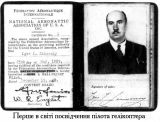 Since the early 30s Sikorsky simultaneously worked with the development of new aircraft and again started the construction of helicopters. Then countries - leaders of the world aircraft industry created and tested the first workable design. Especially great success achieved H.Fokke - German aircraft designer whose helicopters were even released in a small series. Such success of a potential competitor was not overlooked by the U.S. government, and in 1938 the U.S. Congress passed a "Bill Dorsey" (by last name of a Congressman from Pennsylvania F.Dorsi). This document intended to allocate three million dollars to build helicopters for the U.S. Army.
Since the early 30s Sikorsky simultaneously worked with the development of new aircraft and again started the construction of helicopters. Then countries - leaders of the world aircraft industry created and tested the first workable design. Especially great success achieved H.Fokke - German aircraft designer whose helicopters were even released in a small series. Such success of a potential competitor was not overlooked by the U.S. government, and in 1938 the U.S. Congress passed a "Bill Dorsey" (by last name of a Congressman from Pennsylvania F.Dorsi). This document intended to allocate three million dollars to build helicopters for the U.S. Army.
Just then I.Sikorsky had already finished the rough processing of his helicopter construction and was ready to start production of its experimental design. He understood that the transverse scheme, which was used by Fokke to improve the characteristics of machine and which tried to replicate in their design the majority of designers from different countries, had no future. Sikorsky left true single-rotor scheme with tail rotor, work which he began in KPI. It is this scheme that has eventually become dominant in the global helicopter. In September, 1939 he took constructor pilot to test a helicopter VS-300 (S-46). Each flight brought new information on how to behave in the air with such device and what else needed to be done, so he was safe and secure. Work on this helicopter provided the creation of helicopter XR-4 (VS-316), which has successfully passed all tests and was adopted in 1942 by the U.S. Army. Significantly, the car was put into operation only 14 months after the conclusion of its development!
After the modernization and equipage of the helicopter with powerful engine of 180 horsepower it had two versions - YR-4A and YR-4B - was produced and was used by troops till the end of war, not only in the U.S. but also in Britain. At the beginning of 1944 helicopter flew in extremely difficult weather conditions and for the first time in history participated in the operation of saving sailors from the U.S. destroyer "Turner", which was sunk by a German submarine.
Leaders of the world market
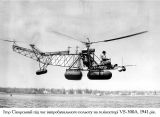 After the war, the U.S. expereinced a real helicopter boom. It was organized by more than 340 firms that undertook the development of helicopter engines for various needs. However, the Sikorsky company won the competition and became a recognized leader not only in America but also on the world market. Its helicopters were widely used in the Army, Coast Guard and civilian life. Especially effective they were in search and rescue and sanitary works. That was fully consistent view of the technique of design: Sikorsky thought helicopters primary concern was saving people, not participation in hostilities. No wonder, according to his son Sergei Sikorsky his father helicopters saved over half a million lives.
After the war, the U.S. expereinced a real helicopter boom. It was organized by more than 340 firms that undertook the development of helicopter engines for various needs. However, the Sikorsky company won the competition and became a recognized leader not only in America but also on the world market. Its helicopters were widely used in the Army, Coast Guard and civilian life. Especially effective they were in search and rescue and sanitary works. That was fully consistent view of the technique of design: Sikorsky thought helicopters primary concern was saving people, not participation in hostilities. No wonder, according to his son Sergei Sikorsky his father helicopters saved over half a million lives.
The huge success of the company was the development of S-55 helicopter, which was issued for more than 12 years, not only in the U.S. but also for licenses in the UK, France and Japan. Exactly that machine of Sikorsky became the first in the history of aviation helicopter, which in 1952 made a transatlantic flight.
New cars were released by the workshops of the company almost every year. These were the helicopters for various needs - from business "air motorcycle" to the world's largest helicopter with reciprocating engine S-56, which could with three crewmen carry a payload of four tons.
The last helicopter designed by Sikorsky in person in the years 1954-1955, was the S-58. In terms of features it was superior to all first-generation helicopters. His numerous modifications operated both military and civil purposes in almost fifty countries. Several countries have bought a license for their production. Many of these machines are used to this day.
In 1957, Sikorsky resigned as chief designer of the company, retaining the responsibilities of the technical consultant. The company was in bloom, releasing monthly 45-55 helicopters. Its factories were equipped with the latest technology, developed new designs. Machine of Sikorsky company owned majority of world records, including an absolute. Sikorsky Aircraft Corporation has taken a leading position in the global helicopter .
Another Sikorsky
In Ukraine Igor Sikorsky is known today as a brilliant aircraft designer, the "father of global helicopter." Much less known in his homeland about his religious and philosophical traditions. The most known of his works in this area are a small book "Message Lord's Prayer," which deals with the analysis of the prayer "Our Father". For the first time it was published in 1941, then reprinted twice. In it grandson of an Orthodox priest and a profound thinker Igor Sikorsky, keeping nearly two-millennium of theological traditions, analyzes the present position of each word of the Lord's Prayer and tells the modern reader about its eternal relevance and value for the soul of a Christian.
It should be mentioned also about the social activities of Igor Sikorsky. He took an active part in the American émigré organizations and was one of the founders and some time even the head of the famous Tolstoy Foundation, which helped compatriots abroad and played a special role in the lives of tens of thousands of people who were deprived of homeland during World War II.
... He died on October 26, 1972. He quietly went asleep and did not wake up. It is said that during his burial people who came to bid farewell to a brilliant contemporary saw in the sky a symbolic sign. Contrail of two aircraft flying perpendicular courses created in the sky a large white cross, as if saying goodbye from great creator of aviation.
Homecoming
For many years the name of Mr. Helicopter, the name given to Igor Sikorsky, so wide-known in the world, was concealed at home - and how could it be otherwise, he was beloved by the royal family! In popular literature, even the authorship of "Ilya Muromets" was attributed to some "group of young designers of RBVZ." Information ice began to break in the late eighties: the mass media showed interest in the personality of Igor Sikorsky, the books were published about him. In 1998, KPI renowned a designer by opening a plaque. It graced the building of the former research workshops, where the former student of the institute shed a lot of working sweat. It was also opened the State Polytechnic Museum of Ukraine. The best students of the Faculty of Aerospace KPI annually receive scholarships of Igor Sikorsky. On campus the graduates constructed the world's first monument to famous designer. At the foot Ukrainian honored sculptor Nikolay Olejnik stamped the words of Igor Sikorsky said by him at the end of his life: " Hats off to alma mater, which prepared me to conquer the sky ». So great compatriot returns home to his native Kyiv, to his alma mater to inspire new generations of KPI students to implement fantastic dreams

